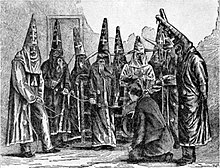
Blasphemous is a Metroidvania video game developed by Spanish studio The Game Kitchen and published by Team17. The game was released for Microsoft Windows, PlayStation 4, Xbox One, and Nintendo Switch on 10 September 2019, with Warp Digital handling the console ports. Versions for macOS and Linux were released on 21 September 2020. A version for Amazon Luna was released on 20 October 2020. It began as a Kickstarter campaign in 2017. A sequel, titled Blasphemous 2, was released on 24 August 2023.
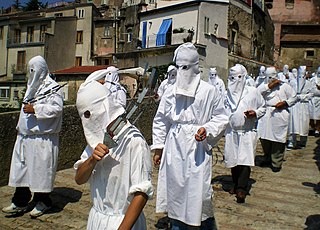
Flagellants are practitioners of a form of mortification of the flesh by whipping their skin with various instruments of penance. Many Christian confraternities of penitents have flagellants, who beat themselves, both in the privacy of their dwellings and in public processions, to repent of sins and share in the Passion of Jesus.
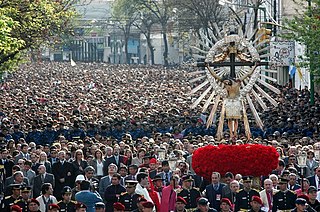
A Holy Week procession is a public ritual march of clergy and penitents which takes place during Holy Week in Christian countries, especially those with a Catholic culture. Various images of the saints, especially the Virgin Mary, and most importantly the image of the crucified Christ are carried aloft by foot on shoulder-borne pasos as an act of penance; acts of mortification are carried out; traditional Christian hymns and chants are sung. In many confraternities of penitents, the faces of the members are covered by elaborate hoods, such as the capirote, as a way of hiding one's identity in order to not ostentatiously draw attention to oneself while performing penance. Crosses, and biers holding Catholic holy images surrounded with flowers and offerings of candles, are carried usually from one parish church to another led by the clergy, monastic orders, or heads of the penitential orders.

Pointed hats have been a distinctive item of headgear of a wide range of cultures throughout history. Although often suggesting an ancient Indo-European tradition, they were also traditionally worn by women of Lapland, the Japanese, the Mi'kmaq people of Atlantic Canada, and the Huastecs of Veracruz and Aztec. The Kabiri of New Guinea have the diba, a pointed hat glued together.
Dunce is a mild insult in English meaning "a person who is slow at learning or stupid". The etymology given by Richard Stanyhurst is that the word is derived from the name of the Scottish Scholastic theologian and philosopher John Duns Scotus.
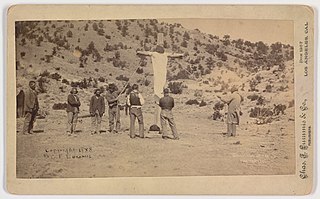
Los Hermanos de la Fraternidad Piadosa de Nuestro Padre Jesús Nazareno, also known as Los Penitentes, Los Hermanos, the Brotherhood of our Father Jesus of Nazareth and the Penitente Brotherhood, is a lay confraternity of Spanish-American Catholic men active in Northern and Central New Mexico and southern Colorado. They maintain religious meeting buildings, which are not formal churches, called moradas.
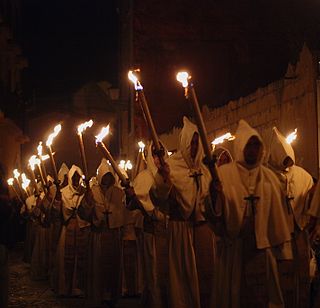
Holy Week in Zamora, Spain, is the annual commemoration of the Passion of Jesus Christ that takes place during the last week of Lent, the week immediately before Easter. Holy Week is the Christian week from Palm Sunday through Easter Sunday. It can take place in March or April. In Zamora, Holy Week is celebrated by 16 Catholic religious brotherhoods and fraternities that perform penance processions on the streets of the city.

The sanbenito was a penitential garment that was used especially during the Portuguese and Spanish Inquisitions. It was similar to a scapular, either yellow with red saltires for penitent heretics or black and decorated with devils and flames for impenitent heretics to wear at an auto-da-fé.

Holy Week in Seville is one of two biggest annual festivals in Seville, Andalusia, Spain, the other being the Feria de Abril, which follows two weeks later. It is celebrated in the week leading up to Easter, and features the procession of pasos, floats of lifelike wooden sculptures of individual scenes of sorrowful Mysteries of the Rosary, or images of the grieving Virgin Mary.

A confraternity is generally a Christian voluntary association of laypeople created for the purpose of promoting special works of Christian charity or piety, and approved by the Church hierarchy. They are most common among Roman Catholics, Anglicans, Lutherans and the Western Orthodox. When a Catholic confraternity has received the authority to aggregate to itself groups erected in other localities, it is called an archconfraternity. Examples include the various confraternities of penitents and the confraternities of the cord, as well as the Confraternity of the Rosary.

Confraternities of penitents are Christian religious congregations, with statutes prescribing various penitential works; they are especially popular in the Catholic Church. Members of the confraternities of penitents practice mortification of the flesh through fasting, the use of the discipline, the wearing of a hair shirt, among other instruments of penance, etc.
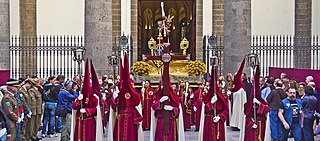
Holy Week in Spain is the annual tribute of the Passion of Jesus Christ celebrated by Catholic religious brotherhoods and fraternities that perform penance processions on the streets of almost every Spanish city and town during the Holy Week –the last week of Lent, immediately before Easter–.

The Inquisition Tribunal, also known as The Court of the Inquisition or The Inquisition Scene, is a 46-by-73-centimetre oil-on-panel painting produced by the Spanish artist Francisco Goya between 1812 and 1819. The painting belongs to a series which also includes Bullfight, The Madhouse and A Procession of Flagellants, all reflecting customs which liberals objected to and wished were abandoned, but their reform was opposed by the absolutist (autocratic) policy of Ferdinand VII of Spain.

A Procession of Flagellants is an oil-on-panel painting produced by Francisco de Goya between 1812 and 1819. In the foreground is a procession of Roman Catholic men dressed in white, wearing pointed hats and whipping their bared backs in penitence. Their backs are bleeding and they pull over-life-size statues of Nuestra Señora dela Soledad, the Ecce Homo and the Crucifixion of Christ. Other devotees, who are kneeling and wearing black hoods, line the route. On the right a man is impaled and all are carrying banners, crosses and lamps.

Los Picaos are public acts of penance of the Christian religion that occur in the town of San Vicente de la Sonsierra in La Rioja (Spain). In Christian processions and Stations of the Cross, members of the Cofradía de la Santa Vera Cruz de San Vicente, a Christian confraternity of penitents, practice self-flagellation of the back by using a discipline as a voluntary act of faith; they are called disciplinantes.

Holy Week in Mexico is an important religious observance as well as important vacation period. It is preceded by several observances such as Lent and Carnival, as well as an observance of a day dedicated to the Virgin of the Sorrows, as well as a Mass marking the abandonment of Jesus by the disciples. Holy Week proper begins on Palm Sunday, with the palms used on this day often woven into intricate designs. In many places processions, Masses and other observances can happen all week, but are most common on , Good Friday, Holy Saturday and Easter Sunday, with just about every community marking the crucifixion of Jesus in some way on Good Friday. Holy Saturday is marked by the Burning of Judas, especially in the center and south of the country, with Easter Sunday usually marked by a Mass as well as the ringing of church bells. Mexico's Holy Week traditions are mostly based on those from Spain, brought over with the Spanish conquest of the Aztec Empire, but observances have developed variations in different parts of the country due to the evangelization process in the colonial period and indigenous influences. Several locations have notable observances related to Holy Week including Iztapalapa in Mexico City, Taxco, San Miguel de Allende and San Luis Potosí.

Holy Week in Salamanca is the most important religious event of Salamanca, Spain. It is celebrated in the week leading up to Easter.
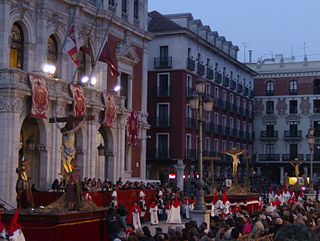
The Holy Week in Valladolid is one of the main tourist attractions, and cultural and religious events of Valladolid and the surrounding province during Holy Week in Spain. It boasts of renowned polychrome sculptures, created mainly by sculptors such as Juan de Juni and Gregorio Fernández, who were active when the city served as the imperial court. The city's National Sculpture Museum has a total of 42 images for the processions. The Holy Week in Valladolid is known to depict the Passion with great fidelity, rigor and detail.

In Taxco, the processions and ceremonies of Holy Week are elaborate and have gained international fame. Between Palm Sunday and Easter Sunday, there are ten major processions, six during the evening and four during the day. Most processions are about two and a half kilometers long and take about two hours to complete. These commemorations date back to at least 1622 when they were begun in the atrium of the Church of the Ex monastery of San Bernardino de Siena. Now these processions and ceremonies center of the Santa Prisca Church.

A nazareno (nazarene) is a member of a brotherhood which performs penance rites during Holy Week in Spain. They parade wearing the clothing that conforms to the rules of the brotherhood. The most common term in use is Nazarenes, in but some regions they are known as capuchones (hoodies),or mozorros (lads) or some variation of implying “worthy of punishment”




